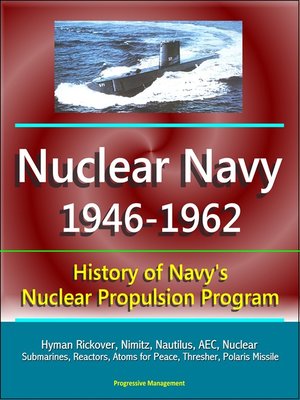Nuclear Navy 1946-1962
ebook ∣ History of Navy's Nuclear Propulsion Program--Hyman Rickover, Nimitz, Nautilus, AEC, Nuclear Submarines, Reactors, Atoms for Peace, Thresher, Polaris Missile
By Progressive Management

Sign up to save your library
With an OverDrive account, you can save your favorite libraries for at-a-glance information about availability. Find out more about OverDrive accounts.
Find this title in Libby, the library reading app by OverDrive.



Search for a digital library with this title
Title found at these libraries:
| Loading... |
This official AEC-sponsored history of the Naval nuclear propulsion program provides an authoritative account of the historic effort to develop the first atomic powered submarines and carriers under the celebrated leadership of Hyman Rickover.Subjects and topics covered include: Hyman Rickover, Nautilus, Admiral Nimitz, President Eisenhower, Walter Zinn, Argonned National Laboratory, Atomic Energy Commission, Bureau of Ships, Nuclear Submarines, Ross Gunn, Naval Research Laboratory, Rear Admiral Mills, General Electric, Babcock and Wilcox, Oak Ridge, Project Genie, Clinton Laboratories, Project Wizard, Reactors (gas cooled, water cooled, liquid metal cooled), Westinghouse, Atomic Power Laboratory, Code 390, Guppy, Tang class, Electric boat, Portsmouth, Mark I and II, Mark A and B, Aircraft Carrier, Atoms for Peace, Shippingport Atomic Power Station, Skipjack, S5W Reactor, Thresher, Polaris, Enterprise Carrier.The story told here has significance for men of affairs as well as scholars. It says much about the innovation and development of a basic new technology under the guidance of the federal government. It describes the complex relationships among the scientists who handled the basic research, the civilian and military officials (usually technically trained engineers), who were responsible for carrying out the programs, and the contractors (usually private corporations), who built the plants, equipment, components, and ships. The study suggests both the problems raised in the process of putting a new technology to work and the techniques and procedures devised to solve these problems. In this way it provides a rare insight into the inner workings of the military and civilian governmental offices carrying out the task. Above all this history emphasizes the critical role played by individual personalities in the execution of a highly sophisticated, impersonal technological program within a large and sometimes impersonal bureaucracy.Nuclear Navy 1946-1962 * Chapter 1 - Control of the Sea * Chapter 2 - The Idea and the Challenge * Chapter 3 - The Question of Leadership * Chapter 4 - The Structure of Responsibility * Chapter 5 - Emerging Patterns of Technical Management * Chapter 6 - Prototypes and Submarines * Chapter 7 - Toward a Nuclear Fleet * Chapter 8 - Nuclear Power Beyond the Navy * Chapter 9 - Propulsion for the Fleet * Chapter 10 - Building the Nuclear Fleet * Chapter 11 - Fleet Operation and Maintenance * Chapter 12 - The Measure of Accomplishment






